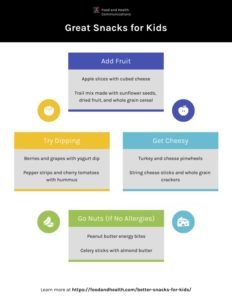Better Snacks for Kids
Remember the days of orange slices and Coleman coolers full of ice water after soccer games? The only package for snacks then was a sweet orange peel!Those days seem long gone. Soccer fields today are littered (sometimes literally) with chip bags and empty Gatorade bottles.With the rate of childhood obesity at an all-time high, most kids probably don’t need a 350-calorie snack after a short practice or one-hour game. In 2019-2020, the rate of obesity in kids aged 10 to 17 was 16.2%. The national rate for obesity in kids aged 2 to 19 rose to 22.4% during the pandemic. 1Our kids deserve better snacks. Nutrient-dense snacks will help them feel better, focus, and could even help prevent premature cases of type 2 diabetes or heart disease.So today, for the next installment of our series, Let’s Get Kids Healthy, this week’s blog is all about snacks!Which Snacks?Snacks are not inherently a bad idea, especially for kids. The right kind of snack can help fuel growing kids' bodies and fill in nutritional gaps. In addition, distributing food throughout the day in smaller quantities may prevent digestive issues. 2Snacks like dairy products can provide needed calcium, vitamin D, and protein in kids’ diets. A small study that evaluated salivary cortisol levels and appetite in children aged 9 to 14 years found that Greek yogurt and cheese (but not milk) reduced appetite and were just as effective as traditional snacks (chips, cookies) at reducing subsequent food intake. 3Dairy products as snacks may also impact blood glucose levels in this age group. A study that evaluated the impact of dairy on overweight and normal weight children found that when compared to a similar calorie level snack, those that consumed dairy had lower post-prandial blood sugar and higher insulin levels. 4According to a 2018 study on snacking habits of US children aged 2 to 5 years, snacks provided 28% of energy intake, 32% of carbohydrates, 39% of added sugars, and 26% of fat and dietary fiber for the day. For the day recorded, snacking accounted for over 46% of all drinks consumed. Snacks and sweets contributed quite a bit of added sugar as well -- 53%. 5Snack AttackSince snacks can add significant sugar and calories to children’s eating patterns, it’s important to give childcare providers and parents healthy options for their kids. For starters, it’s rarely a good idea to reward kids with food, particularly energy-dense snacks. This can set the stage for mindless and emotional eating later in life.A recent study in 3642 children aged 4 to 9 indicated that parents’ use of food as a reward in children aged 4 years predicted Emotional Overeating and Picky Eating at the age of 9 years. Over time, higher Emotional Eating and Food Responsiveness scores were observed with more use of food as a reward. It was not associated with children’s response to satiety, BMI, or risk of being overweight, which is surprising. 6Snacks for Group Activities and After SchoolAs mentioned above, snacks can provide necessary nutrients for growing kids... when they’re the right snacks. Frosted cupcakes or mini bags of Skittles are not the best ideas. Make sure there’s FOOD in the food!Don't worry, we're not going to leave you with a list of things not to do and no actual snack ideas for kids! Here are some suggestions for healthy snacks that are made up of actual food.Not Sure Where to Start? Try These Snack Ideas...
- Trail mix made with sunflower seeds, dried fruit, and Cheerios or Chex cereal
- String cheese sticks and whole grain crackers
- Celery sticks with almond or peanut butter
- Berries and grapes with yogurt dip
- Pepper strips and cherry tomatoes with hummus
- Apple slices with cubed cheese
- Turkey and cheese pinwheels
- Sunflower seed butter energy bites
By Lisa Andrews, MEd, RD, LDPDF Handout: Snacks for Kids References:
References:
- The State of Childhood Obesity - Helping All Children Grow Up Healthy
- Marangoni F, Martini D, Scaglioni S, Sculati M, Donini LM, Leonardi F, Agostoni C, Castelnuovo G, Ferrara N, Ghiselli A, Giampietro M, Maffeis C, Porrini M, Barbi B, Poli A. Snacking in nutrition and health. Int J Food Sci Nutr. 2019 Dec;70(8):909-923. doi: 10.1080/09637486.2019.1595543. Epub 2019 Apr 10. PMID: 30969153.
- Gheller BJF, Li AC, Gheller ME, Armstrong T, Vandenboer E, Bellissimo N, Anini Y, Hamilton J, Nunes F, Mollard RC, Anderson GH, Luhovyy BL. The effect of dairy products and non-dairy snacks on food intake, subjective appetite and cortisol levels in children: a randomized control study. Appl Physiol Nutr Metab. 2021 Sep;46(9):1097-1104. doi: 10.1139/apnm-2020-0909. Epub 2021 Mar 16. PMID: 33725464.4. Gheller BJ, Gheller M, Li A, Nunes F, Anini Y, Glanville NT, Bellissimo N, Hamilton J, Anderson GH, Luhovyy BL. Effect of dairy and nondairy snacks on postprandial blood glucose regulation in 9-14-year-old children. Appl Physiol Nutr Metab. 2019 Oct;44(10):1073-1080. doi: 10.1139/apnm-2018-0549. Epub 2019 Feb 22. PMID: 30794429.
- Shriver LH, Marriage BJ, Bloch TD, Spees CK, Ramsay SA, Watowicz RP, Taylor CA. Contribution of snacks to dietary intakes of young children in the United States. Matern Child Nutr. 2018 Jan;14(1):e12454. doi: 10.1111/mcn.12454. Epub 2017 Mar 23. PMID: 28337856; PMCID: PMC6866248.
- Jansen PW, Derks IPM, Mou Y, van Rijen EHM, Gaillard R, Micali N, Voortman T, Hillegers MHJ. Associations of parents' use of food as reward with children's eating behaviour and BMI in a population-based cohort. Pediatr Obes. 2020 Nov;15(11):e12662. doi: 10.1111/ijpo.12662. Epub 2020 Jun 16. PMID: 32548949; PMCID: PMC7583369.


